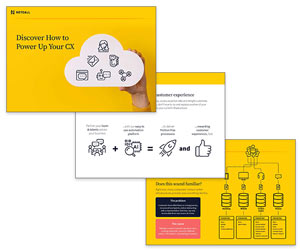We all know exceptional customer service when we get it. It can be so refreshing and such a wonderful experience that customers do comment on it and do tell others.
But this is easier said than done. In her latest article Carolyn Blunt provides some pointers on how to provide exceptional customer service in the call centre.
Creating Exceptional Customer Service in the Call Centre
Customer service is really easy to get wrong. The media will argue that exceptional customer service seems to be rare in contact centres.
This may be for a number of different reasons: unmotivated or un-empowered agents, inadequate systems, lack of training, outdated procedures and a culture that does not properly understand or respond to its customers are the usual ingredients of poor customer service.
So what can you do to turn this around? Here is a simple recipe for success that is sure to sweeten customer service:
1. Sincere smile
A sincere, positive attitude is principle number one. No customer wants to be treated by a bored, sullen agent, and a negative approach will instantly rile a customer and potentially escalate a call.
Smiling injects energy and enthusiasm into your voice, even though the customer cannot see you. The unique use of facial muscles makes your voice sound different, which is why a smile can be ‘heard’ down the telephone.
If after the initial positive and happy greeting given by an agent the customer vents a complaint then the smile can be dropped and a sincere apology given – even if it is only ‘I’m sorry you’ve had to go through that’ which sidesteps any liability pending further investigation!
The sincere change in voice tone will usually gratify an angry customer and allow the agent to proceed to principle 2.
2. Understand
What is this customer calling for? Listen to the words they use and the inflection in their voice. Are they getting annoyed? Are they pausing or hesitant?
Are they in a good mood and seeking a bit of banter? Do they need something sorting out quickly and efficiently? The ability to understand what the customer wants and then to give them what they want is a customer service match made in heaven. Every agent should be going out of their way to give customers what they want.
3. Take ownership
If the agent cannot help then they need to take ownership and find someone who will. Taking the ‘legwork’ out of the matter for a customer is what every employee should be trying to do.
If a caller needs to be transferred to another member of the team then the agent should be the one updating their colleague before the call is put through – letting the customer repeat themselves is a really easy way to wind them up.
Consider whether your organisation is set up for outbound calling to keep customers informed of the progression of their order or issue. Just a quick ‘hello, we haven’t forgotten you, we’re still working on it’ goes a long way.
4. Great expectations
Are your customers’ expectations realistic? Why? Why not? It is true that some people are unlikely to ever be happy but the majority are decent folk who just want to be treated right.
Figures show that the loyalty of a customer who has complained actually increases if their complaint is dealt with quickly and effectively. Are your agents setting realistic expectations about when products will be dispatched or when a service will be working or a call-back made?
5. Do what you say
Failure to deliver on promises is another critical error. Most people are very tolerant if you keep them informed when things go wrong.
Are your agents giving customers a consistent message? If a customer hears what they want to hear from an agent ‘just to get them off the phone’ it only serves to disappoint them even further when the promise isn’t delivered. If your agents are saying they are going to do something then they certainly should do it.
6. Empower your advisors
Consider how far you can empower the front line to resolve customer issues. Having too many bureaucratic levels of sign-off for meeting customers’ expectations may cost more than it saves.
If your agents are not supported by working systems, or there are problems elsewhere in the organisation (warehousing, sales, field staff, etc.) then this is unfair and, with the best will in the world, working with your agents is unlikely to fix the real issue that is blocking your customer service from being exceptional.
This is the acid test that we conduct with every new client – the last thing we will do is sell a fix for a perceived soft-skill training need in the contact centre when the crux may actually be an operational issue elsewhere. That simply wouldn’t be good customer service or deliver the expected results!
7. Action
Making exceptional customer service part of an active customer service culture is the key to sustained improvements. A five minute huddle at each shift change can be invaluable for focusing everyone on customer needs and communicating key pieces of new or changing information that customers may like, need, or want to know.
Too many contact centres update their agents through cascaded emails which pale into insignificance in the face of a flashing wallboard. They just don’t get read.
Team leaders need to take action to focus, motivate and praise good customer service efforts. Shout about positive customer comments and provide immediate coaching for those who deliver a less than exceptional customer service experience.
If agents don’t know clearly what standards of customer service are expected or how to deliver on them it is unlikely they will automatically start doing it.
However, with some quality attention and training we’ve seen agents increase customer satisfaction and call quality by 20% with ease. Take action – communicate and motivate them to do it for your customers!
8. Review
Reviewing calls is essential to provide feedback and coaching. Ask agents – What went well in that call? How do you think that caller felt? What did that caller really want from us? What could we have done to make them happier? This really focuses their minds on individual customers’ needs.
Reviewing complaint data and customer satisfaction scores and feedback provides a useful starting point for gap analysis – what is the gap between what your customers are saying and what you want them to say? How can this be addressed?
Some of it may be ‘knowledge’ or ‘skills’ that can be improved with operational or systems training. Some of it may be ‘attitudes’ that can be improved by good quality soft-skills and communication training.
Is your contact centre fitting cohesively with the other parts of your organisation? Remember: for exceptional customer service the organisation has to work together to ensure there are no weak links in the service chain. Otherwise your contact centre can bear the brunt.

Carolyn Blunt
Carolyn Blunt is a contact centre training expert with Real Results Training and was voted 2nd Most Respected Person in the Contact Centre Industry by readers of Call Centre Helper.
Author: Jonty Pearce
Published On: 16th Dec 2009 - Last modified: 17th Feb 2025
Read more about - Customer Service Strategy, Carolyn Blunt, Customer Service, CX, Motivation








































